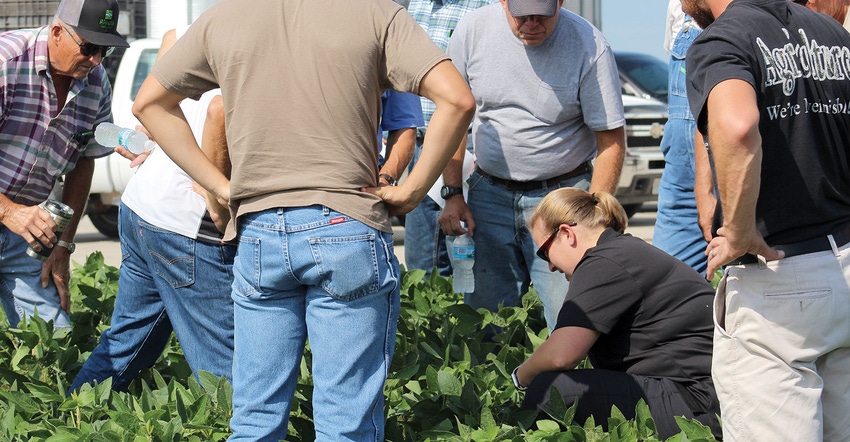
Not all soybean diseases require a fungicide application, says University of Missouri Extension plant pathologist Kaitlyn Bissonnette.
Knowing if and when to spray fungicides saves money and reduces concerns about fungicide resistance, Bissonnette says.
She shares information about soybean diseases in a series of sessions on disease scouting throughout the state. Missouri Soybean Merchandising Council and MU Extension sponsor the sessions.
Timing, method and rate of application determine fungicide efficacy, says Bissonnette. Many common diseases don’t affect yield and don’t warrant treatment.
Always follow label instructions for best results. Fungicides applied too early often lack efficacy, Bissonnette says. Little fungicide may remain on leaves by the time disease shows. Most disease does not require a fungicide application before early pod development (R3 growth stage).
Bissonnette says farmers should check weather patterns and the disease-resistance level of their varieties when making fungicide application decisions. Regular scouting of the field, starting at the edges and walking to the interior areas, provides early detection of pests. Know your diseases. Some are easily identified while others are harder to distinguish from other types of crop damage, she says. An integrated pest management system that includes crop rotation and the use of resistant varieties is always the best approach.
Some require little treatment
Bissonnette gives a brief overview of diseases that seldom require foliar fungicide treatment:
Septoria brown spot shows as brown spots in the lower canopy of soybean. It often appears early in the season. The disease causes leaves to yellow and drop prematurely but does not generally affect yield. It thrives during warm, wet weather and in continuous soybean fields. Rotate fields to avoid.
Bacterial leaf spot appears in the upper canopy as small brown or light green spots surrounded by yellow halos. Both it and septoria brown spot appear around the same time and can be confused. It also does not affect yield and requires no treatment.
Downy mildew first appears as pale green or light yellow blotches on the upper surface of young leaves. On the underside of the leaf, a gray, fuzzy growth appears after heavy dews. Fungicides are not recommended to control downy mildew. Crop rotation and clean seed are the best management options.
Sudden death syndrome (SDS) often looks like other diseases such as stem canker or brown stem rot. Unlike those diseases, however, the stems of soybean infected with the SDS fungus remain green. First symptoms of SDS are yellowing (chlorosis) and tissue death (necrosis) between leaf veins resulting from the movement of a toxin from the roots into the leaves. Because infection is in the roots, the disease will not respond to foliar fungicide. Choose resistant seed varieties and rotate crops between soybean and small grains or other non-host crops. Plant into warm soils and improve soil drainage.
Soybean cyst nematode (SCN). This microscopic roundworm historically has been controlled with resistant varieties, most of which contain genes from the PI 88788 resistance source. However, the nematode has begun to develop resistance to these genes. In Missouri, two other resistant sources are available: Peking and Hartwig. Bissonnette suggests testing soil for SCN nematode numbers. Test in the fall after harvest or in the spring before planting.
“Know your number,” she says. “Testing tells how many eggs are in the soil and provides insight for future management needs.” In a single season, three to six generations of SCN can appear, with each female containing around 250 eggs. To test for SCN, submit samples to MU’s SCN Diagnostic Lab. Visit scndiagnostics.com for more information. Rotating resistant varieties as well as non-host crops such as wheat and corn is suggested to manage SCN.
Charcoal rot. This late-season disease appears in dry years. It overwinters in the soil, so it is important to scout fields with a known history of charcoal rot. Light gray discoloration and premature yellowing of the leaves occurs. Leaves also are smaller than normal. Fungicides do not help.
Frogeye leaf spot
Bissonnette says frogeye leaf spot (FLS) has been verified in parts of Missouri recently. FLS, which can reduce yield by up to 35 percent, is one disease that can benefit from fungicide treatment. It generally appears in the middle of the growing season. FLS can be anywhere in the soybean canopy, but infection begins in newer leaves. The fungus that causes FLS survives in infected seed and soybean residue. It favors warm, humid weather. Rotate crops and select resistant varieties.
If applying a fungicide to control FLS, Bissonnette recommends using one with multiple modes of action. Before you spray, know if your soybean variety has resistance to FLS and scout for the disease. Ask agronomists in your area if FLS has been reported. Spray when soybean are at the R3 growth stage. “Preventative is always better than curative,” she says.
Agronomists at county MU Extension centers are available to help. You may also send plant samples to the MU Plant Diagnostic Clinic. Call (573) 882-3019 or visit plantclinic.missouri.edu for more information.
Bissonnette also recommends the publication “Determining Fungicide Efficacy” from the United Soybean Board. The publication gives research-based information from several university plant pathologists on the efficacy of many commercially available fungicides toward common soybean diseases. Download at iwilltakeaction.com/resources/fungicide-efficacy-fact-sheet.
About the Author(s)
You May Also Like




